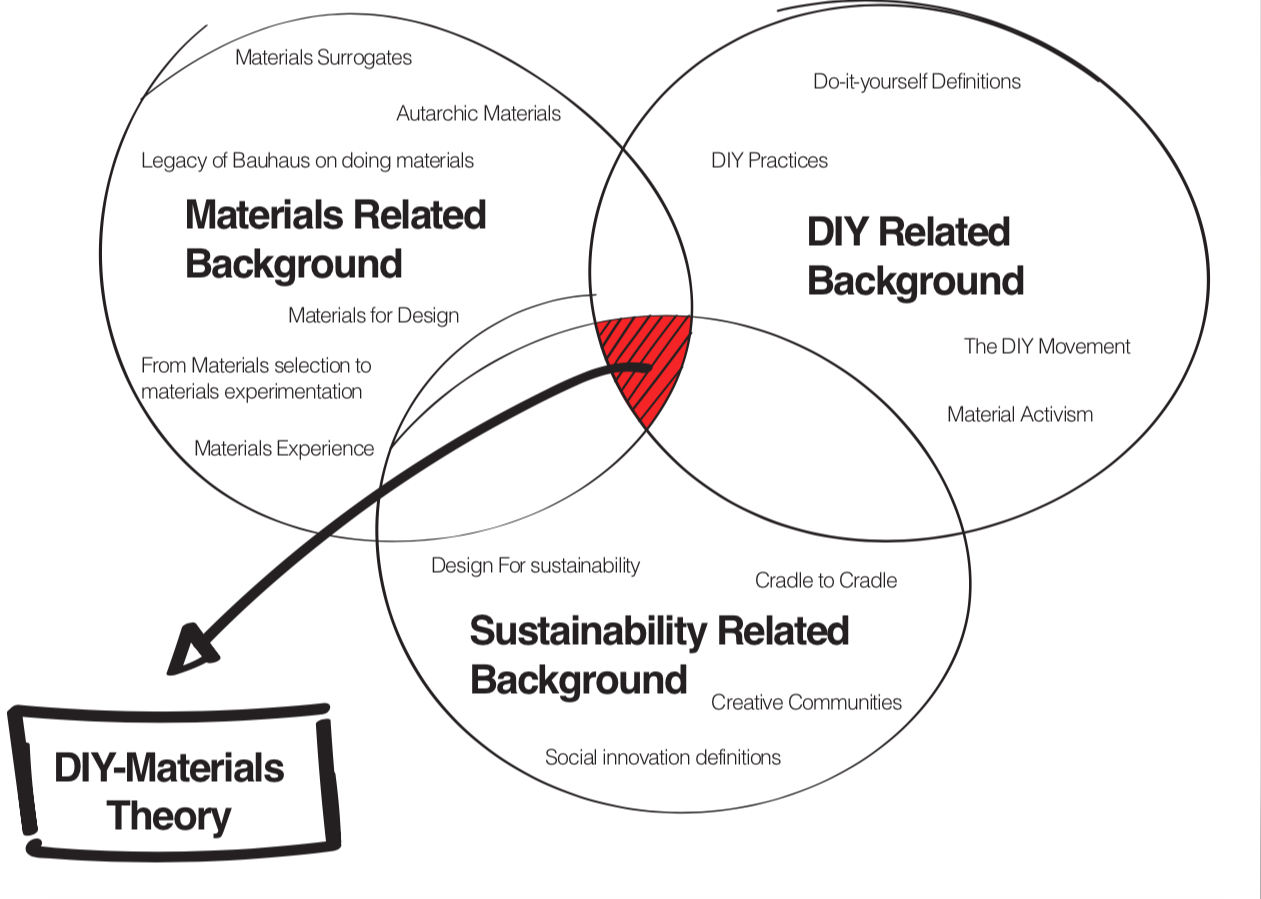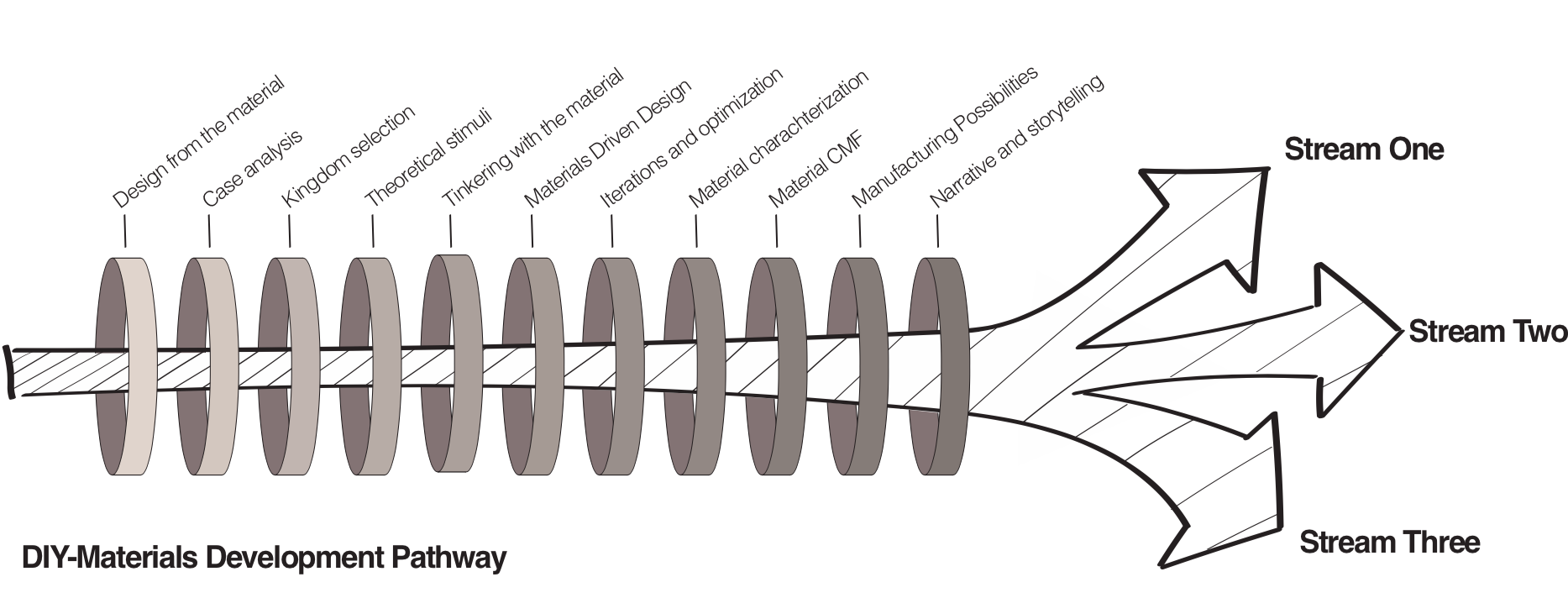the materials generation
The emerging experience of DIY-Materials
The DIY movement is expanding beyond products to include the materials from which the products are made; namely, DIY-Materials. Designers around the globe are engaging in different experimental journeys encircling the materials development field before developing their projects. The design process includes the phase in which the material is developed, and this phase influences the whole creative pathway. Self-made material sources are providing designers with a unique tool to develop new languages and new products with original and fresh materials experiences. As more designers take this path of materials development, which can be defined as design driven, a proper study around the phenomenon needs to be carried out. This research presents a series of studies conducted to understand the DIY-Materials phenomenon as one of the emerging materials experiences in the field of design.
The research was called “Materials Generation” on purpose as it takes advantage of the double meaning of the expression. It refers to the new generation of designers who are aware of the possibilities that emerge when a project starts with the generation of material.
This research aims to describe and define the phenomenon of self-production of materials. It is grounded in the development of a series of codes and categories inside a system of rules to organize information around this particular class of materials. The proposed theory is composed of a language that allows seeing everything that surrounds from an alternative perspective. Living in a world of matter, everything we can touch, smell, see, hear and taste build up our lives. After the industrial revolution, societies were shaped in the way the technological advancements evolved. However, there is an alternative point of view. There is another way to see the world. The DIY-Materials theory is an attempt to produce a system of rules and conventions to categorize the different sources available on the planet and the technologies to transform them. Different from traditional sciences and economic approaches, where extraction of natural resources, mass production and trade of goods around the globe are the driving force, the self-production of materials offers a series of alternative principles and methodologies able to guide a more autonomous and independent way to produce things. It helps to relief from the weight and responsibility to depend on the current dominant world economy. Promotes an alternative idea of smart use of resources, considering resource the elements that before weren`t even considered. This research proposes a sustainable and circular perspective which can promote new social innovations starting from the materials. Within, it is possible to view and understand the opportunities DIY-Materials offer when considered as a possible practice in the design domain.
DIY-Materials as an alternative to traditional materials developed by science.
In order to distribute the different subjects coherently, the research has been structured by formulating the research questions and hypotheses, the qualitative methods and strategies to conduct different tests, and how the different elements are attempting to define this phenomenon together clearly.
The goal of this research is to provide more insights into the phenomenon of DIY-Materials, by creating a theoretical framework for reference with a series of steps to develop a material form an experimental design approach.
The dissertation consists of four main parts.
Part one: The first two chapters are the introductory part. They provide an introduction and overview of the entire research, focusing the attention on the organization and development of the research.
Part two is the theoretical background: inside chapter three there is a summary of the different theoretical elements considered during the research. Made with a brief historical review of the materials for the design domain, moves to the theoretical foundations of the DIY and the DIY practices. The chapter ends with a focus on sustainability-related theories. The three topics construct the three macro areas of research.
The three macro areas of research and where the DIY-Materials Theory is placed.
Part three presents the different studies conducted during the Ph.D. research: The initial three chapters of this part present the exploratory studies conducted to understand the DIY-Materials phenomenon better. This part is composed of three exploratory studies: cases collection and categorization (Chapter Four), evaluation (Chapter Five) and aesthetical evaluation of DIY-Materials (Chapter Six).
The latter two chapters present the test studies conducted to validate hypotheses and gather insights for the DIY-Materials theory building: DIY-Materials development level I (Chapter Seven) and DIY-Materials development level II (Chapter Eight).
Pentagon instrument with the different motivations for DIY-Materials by designers.
Part four is composed of the different outcomes of the research as well as the discussion and general conclusions of the research as an original contribution to the field of study. Chapter Nine presents the different outputs of the different investigations, proposes a roadmap for the efficient development of a DIY-Material with a test study and presents two strategies for the dissemination of the DIY-Materials theory. Finally, Chapter Ten poses a discussion on the conducted research highlighting possible opportunities for the future of this phenomenon together with a report of activities, dissemination work and credits to all designers who participated in the research.
The DIY-Materials Roadmap schema.
Anticipating some of the personal reflections emerged at the end of this Ph.D., is possible to say that designers have not only the possibilities to generate materials, but also have the tools to produce them creating meaningful experiences. The different studies produced during this dissertation in addition to the material samples and physical results become essential elements enriching the DIY-Materials Theory. The results of this research will spark curiosity and hopefully also interest and passion around the materials development, highlighting the possibilities design have to offer to the materials science and engineering domain.
All cases studied classified into five kingdoms: Vegetabile, Animale, Lapideum, Recuperavit and Mutantis.
Publications
-
Ayala-Garcia, C., Rognoli, V. (2019). The Materials Generation. in L. Rampino, I. Mariani (Eds.), Advancements in Design Research. 11 PhD Theses as we do in Polimi. (pp. 197-219). Milano: Franco Angeli. ISBN 9788891786197
-
Rognoli, V., Ayala-Garcia, C. (2018). Materia emocional. Los materialesen nuestra relación emocional con los objetos. In: Revista Chilena de Diseño, rchd: creación y pensamiento, vol. 3 (4), pp.1-12. ISSN:0719-837X
-
Ayala-Garcia, C., Rognoli, V. (2017). The New Aesthetic of DIY-Materials,The Design Journal, 20:sup1, S375-S389.
-
Rognoli, V., Ayala-Garcia, C. (2017) Material Activism. New hybrid scenarios between design and technology. Cuadernos 70 Journal, Universidad de Palermo, N 70-2018 pp. 105-115 ISSN 1668-0227.
-
Ayala-Garcia, C., Rognol, V., Karana, E. (2017). Five Kingdoms of DIY Materials for Design. In Alive. Active. Adaptive: Proceedings of International Conference on Experiential Knowledge and Emerging Materials (EKSIG 2017), June 19-20, Delft, the Netherlands, pp. 222-234.
-
Parisi S., Rognoli V., Ayala-Garcia C. (2016). Designing Materials Experiences through Passing of Time, Material Driven Design Method applied to Mycelium based Composites. In: Proceedings of 10th International Conference on Design & Emotion, Amsterdam, The Netherlands, September 2016 pp.239-255
-
Rognoli V., Ayala-Garcia C., Parisi S., (2016). The emotional value of Do-it-yourself materials. In: Proceedings of 10th International Conference on Design & Emotion, Amsterdam, The Netherlands, September 2016. Pp. 233-241.
-
Rognoli, V., Bianchini, M., Maffei, S., & Karana, E. (2015). DIY Materials. Special Issue on Emerging Materials Experience. Materials and Design, vol. 86, pp. 692–702; DOI 10.1016/j.matdes.2015.07.020
Funded By
Colombian Government
Los Andes University-Colombia





